This was a tough one - combined image of 11.8 magnitude dropping to 13.0, only 16 degrees from an 80% waning moon, only 32 degrees up in the Eastern sky. The path was predicted to cross northern Silicon Valley and miss Santa Cruz, but my odds from upper Bonny Doon was 24% which wasn't bad. Tonight was Mary's annual Christmas party, and an excellent party it was. Great conversations with some old friends and new ones too. Got to meet R.W. Goodwin, exec producer of my favorite TV-series: The X-Files, and had an educational moment on "the business".
So, the occultation was at 10:50pm, requiring an early exit from the party, and driving up to Locatelli Ranch where I could get a clear view of the sky, and also maximize my odds by getting closer to the predicted path. I was excited to be using the Owl 0.5x reducer in chain with the Meade f/3.3 and get the easy 12th magnitude limiting magnitudes Derek Breit gets.... but, it was not to be. The f/3.3 Meade and Owl were just too much compression, and I could not pull the focal length tight enough to achieve focus - not even close. I've now got a Meade f/6.3 reducer in the mail and this is the same configuration as Derek uses (albeit with a different Watcom videocam). My "Plan B" was to pull out the Meade f/3.3 and go with strictly the Owl 0.5x as the only focal reducer, and this got to focus no problem. But, it didn't get me deep enough to see the star. I could just barely see the other 11th mag pair of stars just to the north at brief moments when setting up the final positioning, so I hoped that I could pull the star out in post-processing, perhaps with frame stacking. Conditions were otherwise excellent, and I got the recording, and no idea whether I had an occultation or not.
The next day, I found that there was a clean miss recorded from +89km north, which meant I had higher odds of being in the path at -82km south. I was 9km north of Derek, and well south of Rick Baldridge, who nominally had the best odds, being in the path from Campbell. Alas, he went to a Sharks hockey game that night, and the rest of the occultation people in the path east were under clouds, as the entire 2/3 of the Eastern side of the U.S. was having bad weather. So, it was just me.
Reductions Adventure!
Dec 26: I captured the video with Windows MovieMaker, downloaded the new Tangra 1.4 because I need frame stacking to even see the target star at all and LiMovie doesn't do this. I tried a frame stacking of 8x and pixel size of 2.5 radius for an initial pass through, and it does look like I had an occultation, although noisey. The predicted duration was 9.4 seconds maximum and predicted time was 6:50:25 UT. The captured video starts at 6:49:17.209 or close to it. And ends at frame 4088 at 6:51:32.963. I'm not sure why, but the UT times seem to be blurred in the hundredths and thousandths of a second. I've not seen that before.
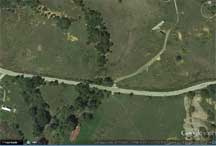
Observing site; next to the gate on the dirt road at center, a few feet from Empire Grade, in Locatelli Ranch. Coordinates in Google Earth shown at the bottom of the image
|
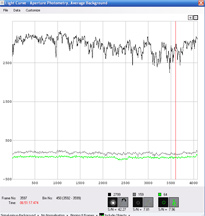
Tangra plot of the 8-frame integration 2 minute light curve centered on the predicted occultation. The bright star at upper right in the image wrecked the scaling, and I don't see in Tangra how to adjust the vertical scale. However, the occultation looks to have happened from frame 2250 to 2550 or thereabouts. |
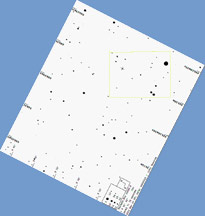
This is the finder chart, 30m (highest res) version off Preston's page. To match the view in the camcorder required rotating 63 degrees counterclockwise, with no image reversal. Image reversal is only needed when using the Diagonal and eyepiece. The star's altitude was 32 deg, azimuth 105 deg. Declination +8.5. The yellow box is the FOV of the chip, with just the Owl 0.5x reducer, looks about 9'x12' size.
Program whatsup.exe says I need to rotate by not 63 ccw, but 51ccw. Could that be right, and I just didn't accurately have the 1/4x20 bolt hole straight up, but off by 12 degrees? Maybe. |
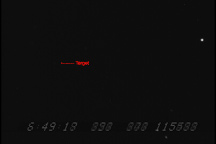
Here is a 64-frame average produced in Tangra 1.4, as a dark frame. Without averaging, the target star is invisible, so this is impressive. This dark frame was NOT used in the initial reduction done at left.
|
Tried again; this time using 3.25pixel radius, and using brightness contrast, and applying dark frame. It didn't work. The image was very dark and nearly all frames failed. So I tried again, this time not using the dark frame and not using brightness/contrast, but still using 3.25pixel. I used the dim star just above the numbering again as comparison, and the brighter star at bottom below numbering as the guide star, just to get the light curve not so squashed. It indeed looks like there was an occultation of about 9 seconds. Problems with the time stamp; I might try to re-use Windows MovieMaker to capture with better time stamping? I asked for an output .csv file, but the times are all question marks. Apparently Tangra doesn't interpolate times from the given begin/end times. I am also not sure if it's really giving the difference between the comparison and target star, or just the raw brightnesses of each, on these plots.
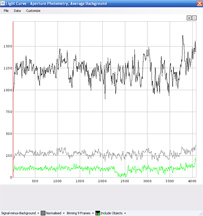
3.25 pixel radius, and dimmer guide star. Otherwise the same as first reduction. I asked for an 8 frame average, stepped. Not sure why it says 9 frame at the bottom of this light curve. |
|
Dec 27: Tried some more with Tangra. I was not able to use the dark frame created, nor get it to recognize the OSD display, which was blurred in the fractions of a second even if clicking 'show field'. The guiding circles did big jumps most of the way across the frame after about a minute of successful tracking, for no reason I could ascertain, if I used either of the stars down in the little 'triangle' near the OSD. Perhaps it was blocking off reading inside the OSD display and if any one star hit the blue boundary, it ran off? Anyway, I have a light curve, showing the occultation and frame numbers. Note one dot every 8 frames since I used 8 frame integration. Clearly noisey around the D and R and so I need to re-do, but here is what I have so far. This uses only the big saturated star as a guide, no comparison, and the target as occulted star.
| |
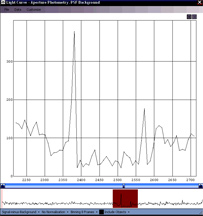
I judge the D at frame 2304, the R at frame 2594 (9.66 sec occn) but the R might be at frame 2557 (8.43 sec), which might be more likely, given the predicted 9.4 sec max duration. |
will try again later to see if I can figure out how to use dark frame and comparison stars properly..
So far, here are questions I have about using Tangra, which I have in my initial readings, not found how to deal with....
Issues with Tangra:
* Can only specify OSD blue border before targeting stars, not after
* Once you specify OSD area at the beginning of your processing, it won't let you select your stars. It seems to be one or the other, not both
* The OSD display is blurred in the fractions of second, even before selecting integrating frames
* You can produce and load a dark frame, but after the dark frame loads the video is very dark, and even the brightest stars are mostly gone, as is the OSD
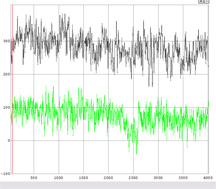
This attempt used 4-frame integration, stepped, with comparison star just above OSD and guide start the saturated bright star. 3977 frames from 6:49:17.190 to 6:51:29.30 |
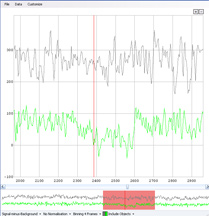
By eye judged D at frame 2385. |
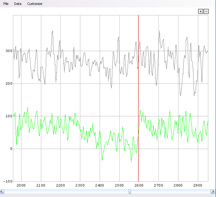
by eye judged R, frame 2599. |
|
Dec 28
Tried again. Opened video, did 8-frame sliding integration, pre-processing 2x stretch, then 'jump to' frame 36 to get past the initial integrations and setting, and then selected guide (bright upper right star), comparison (dimmer star lower left above OSD) and occulted star, and 'start'ed. Over 30 frames were "unsuccessful" but none of them were anywhere near the occultation period. 3977 frames processed, it said. So, using sliding integration it keeps the full time resolution. I used 6 pixel as the size of the circle, for all stars. The theory being, to make sure an include all light for these slightly fuzzy stars. No dark frame was applied because I've not been able to do so successfully. The dark frame seems to kill not just the thermal noise, but the stars too, pretty much.
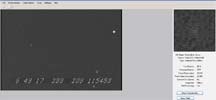
The "bright star" used for guiding is at upper right, and saturated near the peak of the Guassian. The comparison star is closer in brightness to the target, just above the OSD numbers at lower right. The target is ID'd using the two similarly faint stars to the upper left of it, shown on the finder charts as well. |
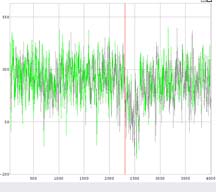
The occulted star only, graphed. It's clear there's an occultation, but the D is kind of sloppy. To my eye, it looks like the unocculted level for the star+asteroid is 251, and the occulted level is 92.
|
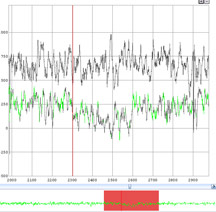
The D is at frame 2300, decided as follows. There is a correlation observed, such that when the comparison star dips down, the target jags upward, as one would expect if the differential magnitude is being plotted. But at frame 2300 both comparison and target show a similar sharp drop, although not an unusual drop for the comparison, the target never regains earlier peaks.
|
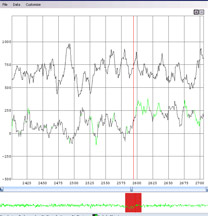
The R is at frame 2592, as both comparison and target make sharp rises, and the other wiggles just before indicate it's still occulted.
|
|
If frame 36 = 6:49:17.016, and frame 3994 = 6:51:29.003 according to the Tangra info panel below and based on my reading of the blurred numbering of the two frames presented...(I think that's what Tangra is doing). Then I get
131.987 seconds = 3958 frames = 29.987 frames/second
duration = 292 frames = 9.737 seconds
Used my program TANGTIM.EXE to do the simple math... (found in c:\camcorderAVI)
If the frame number assigned to a data point is the integration of the 8 frames CENTERED on that frame, then no time correction is needed. I assume so. Then,
D is at frame = 2300-36 = 2264 frames past first timed frame. 2264 frames = 75.499 seconds, so time is 6:49:17.016 + 75.817 gives...
D: 6:50:32.513
R: 6:50:42.251
Using instead the video frame rate in Tangra's source info window shown below of 29.970 frames/sec gives
D: 6:50:32.558
R: 6:50:42.301
which is only 0.05 seconds different and lost in the other noise of the event. I'd put an accuracy on the D of +- 8 frames or 0.26 sec, and on the R of +- 6 frames or 0.2 sec.
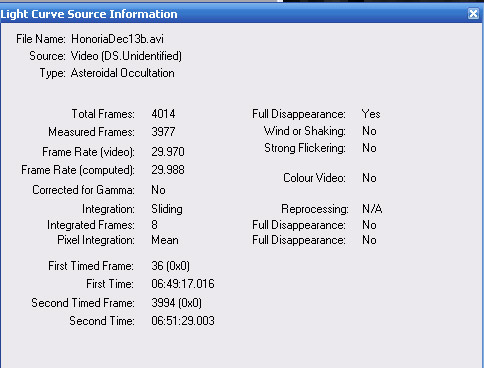
Tony George's Reduction of the .avi file using his software
"I did a standard Limovie analysis without integration. Then I performed an analysis with ROTE. I detrended the data, as there was a slight downward trend in the light curve brightness. Then I did a standard square wave analysis. Here is an excerpt of those results:"
D (readings) = 2303.00 (+10.602/-9.768)
R (readings) = 2600.00 (+9.768/-10.602)
D (seconds) = 76.851110 (+0.354/-0.326) @ 2013-12-13 06:50:33.523740
R (seconds) = 86.762000 (+0.326/-0.354) @ 2013-12-13 06:50:43.434630















